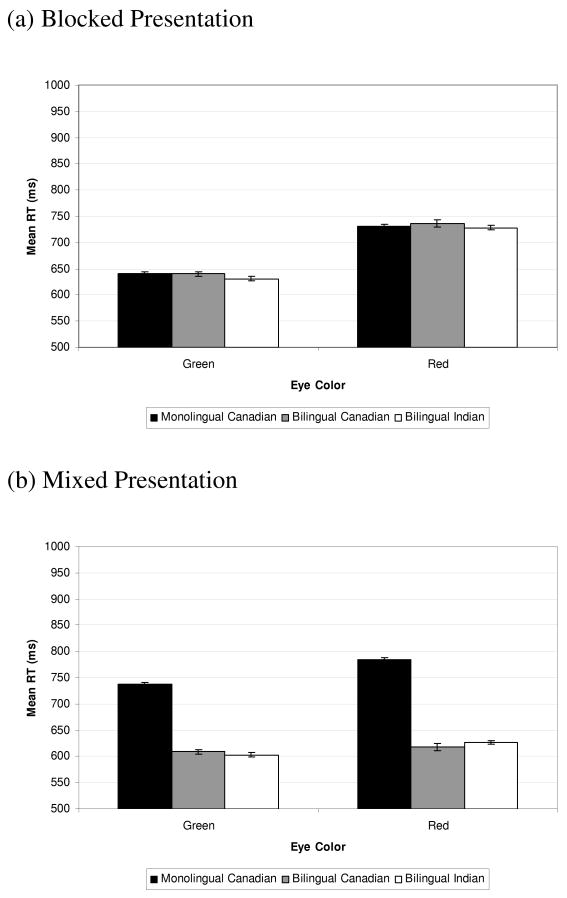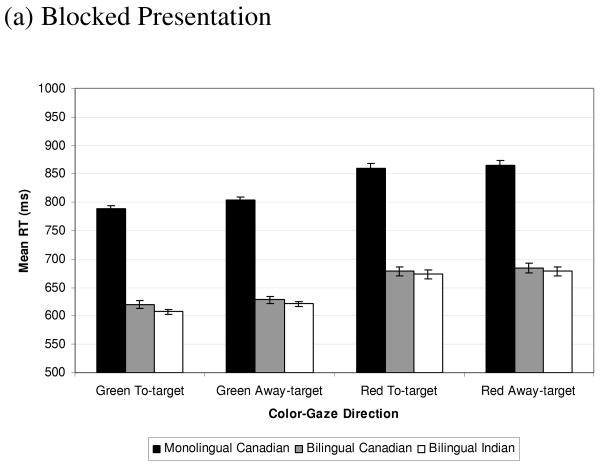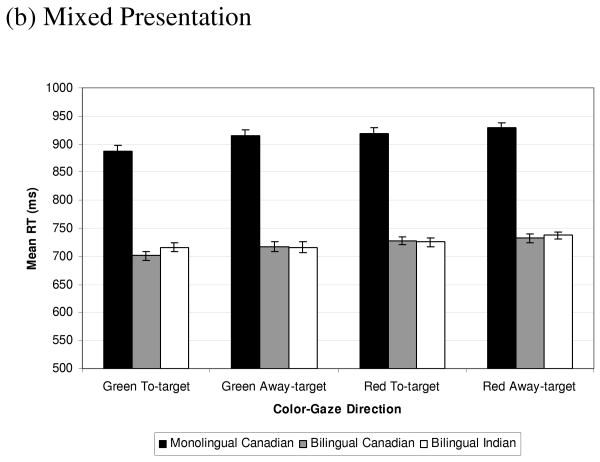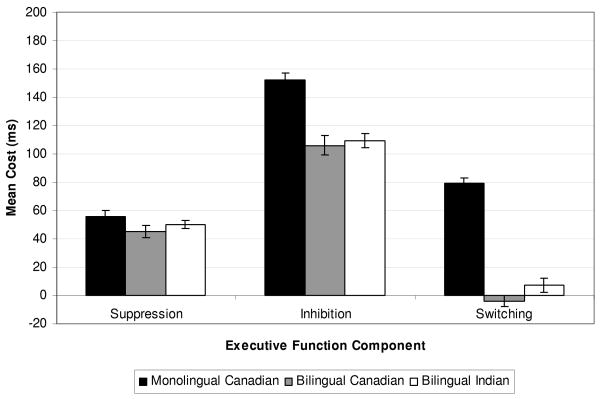Abstract
The present study used a behavioral version of an anti-saccade task, called the ‘faces task’, developed by Bialystok, Craik, & Ryan (2006) to isolate the components of executive functioning responsible for previously reported differences between monolingual and bilingual children and to determine the generality of these differences by comparing bilinguals in two cultures. Three components of executive control were investigated: response suppression, inhibitory control, and cognitive flexibility. Ninety children, 8-years old, belonged to one of three groups: monolinguals in Canada, bilinguals in Canada, and bilinguals in India. The bilingual children in both settings were faster than monolinguals in conditions based on inhibitory control and cognitive flexibility but there was no significant difference between groups in response suppression or on a control condition that did not involve executive control. The children in the two bilingual groups performed equivalently to each other and differently from the monolinguals on all measures in which there were group differences, consistent with the interpretation that bilingualism is responsible for the enhanced executive control. These results contribute to understanding the mechanism responsible for the reported bilingual advantages by identifying the processes that are modified by bilingualism and establishing the generality of these findings across bilingual experiences. They also contribute to theoretical conceptions of the components of executive control and their development.
A growing body of research has demonstrated that executive control develops earlier in bilingual children than in monolinguals (Bialystok, 2001; Carlson & Meltzoff, 2008; Kovacs, 2009), is more efficient in young adults than in their monolingual peers (Bialystok, 2006; Costa, Hernandez, & Sebastián-Gallés, 2008; Colzato et al., 2008), and is maintained better by bilinguals in older age (Bialystok, Craik, Klein, & Viswanathan, 2004; Kavé, Eyal, Shorek, & Cohen-Mansfield, 2008). However, there are two gaps in this literature. The first is an identification of the components of executive control that are affected by bilingualism upon which explanations can be based, and the second is a clear attribution of these effects to bilingualism rather than to some other factor that might correlate with bilingualism.
‘Executive control’ refers to a set of interrelated processes in the frontal lobes but there is debate over the precise components of this broad set of abilities and the degree to which the components develop and function independently of each other. A widely accepted view proposed by Miyake et al. (2000) is that the executive control system consists of three components: inhibition, updating (also called working memory), and shifting (also called cognitive flexibility). Moving beyond descriptive evidence towards an explanation for how bilingualism affects the development and function of executive control depends on identifying the relevant components.
Although there is evidence for a facilitative effect of bilingualism on executive control, there is less agreement about the components of executive control that are affected by bilingualism. Green (1998) has argued that inhibitory control is the relevant process, but inhibition is not a unitary construct. Distinguishing between active and reactive inhibition, Colzato et al. (2008) showed bilingual advantages only for the latter. A further distinction is between inhibition of an interfering cue and inhibition of a habitual response, which Bunge and colleagues have labeled “interference suppression” and “response inhibition”, respectively (Bunge, Dudukovic, Thomason, Vaidya, & Gabrieli, 2002). In the first case, conflict is resolved by selectively attending to a relevant stimulus cue and ignoring a competing cue, and in the second, by refraining from executing an automatically-cued response. Studies with children have shown that bilinguals outperform monolinguals on conflict tasks that require interference suppression, what we call “inhibitory control” (Bialystok & Senman, 2004; Bialystok & Shapero, 2005) but not on those that require response inhibition, what we call “response suppression” (Bialystok, Craik, & Ryan, 2006; Carlson & Meltzoff, 2008; Martin-Rhee & Bialystok, 2008). In contrast, Meuter and Allport (1999) claim that the relevant component is cognitive flexibility, for example, the ability to switch between tasks. Studies with adults have supported this position (Bialystok, Craik, & Ryan, 2006; Costa et al., 2008), although the involvement of cognitive flexibility has not been demonstrated for children. Thus, to understand the effect of bilingualism on cognition it is necessary to identify the components of executive control modified by bilingualism in the same population using a task that can reveal all relevant processes and integrate with lifespan research.
It is especially important to establish the source of the bilingual advantage for children because the components of executive control emerge at different times (Carlson, 2003; Diamond, 2002) and bilingualism may have different developmental influences at different ages. No study to date has compared the effect bilingualism on each of these components in children. Moreover, evidence for an effect of bilingualism on the development of some components but not others will inform theoretical models of executive control by distinguishing among component processes. The present study addresses this issue by using an executive control task, called the ‘faces task’, that allows for the calculation of three discrete component processes.
The second issue is one that applies to all between-groups designs, namely, the comparability of the groups and the generalizability of the results to designated populations. In addition to the obvious difference in language background, monolingual and bilingual children may differ as well in terms of social experience, such as immigration or social class. Nonetheless, research examining bilinguals with different language pairs, different immigration histories, or different social classes has produced comparable results. For example, in the research by Martin-Rhee & Bialystok (2008), the bilingual children in Study 1 spoke English and French and none were immigrants; the bilingual children in Study 2 spoke different non-English languages with mixed immigration patterns; and the bilingual children in Study 3 primarily spoke Hebrew and were largely immigrants. Carlson and Meltzoff (2008) compared lower-class Spanish-English bilingual children to middle-class monolingual English-speaking children and still found advantages for bilingual children on tasks assessing executive control, especially when initial differences in English proficiency had been controlled. Thus it seems unlikely that some hidden factor is responsible for the results. However, in cases where the children were born in their current country, their parents were likely immigrants so the effect of immigration cannot be ruled out. The present study addresses this issue by including a sample of bilingual children who live in the same community and attend the same schools as the monolingual children and a sample of bilingual children who have equivalent experience in using two languages and similar socioeconomic background but live in a different country and have no history of immigration.
Method
Participants
Ninety 8-year-olds were distributed equally across three groups: monolingual English speakers in Canada (mean age = 8.5 years, SD = 0.5, Range = 7.1 – 9.2, 15 girls), bilingual children in Canada who spoke English plus one of Cantonese, Croatian, French, Hebrew, Hindi, Kannada, Mandarin, Marati, Punjabi, Russian, Tagalog, Telugu, or Urdu (mean age = 8.5 years, SD = 0.5, Range = 7.1 – 9.4, 15 girls), and bilinguals in India who spoke English and either Tamil (n = 26) or Telugu (n = 4) (mean age = 8.6 years, SD = 0.5, Range = 7.1 – 9.4, 18 girls). All the bilingual children were being educated in English and spoke the other language at home. It was not feasible to include a monolingual Indian group because in Indian society such children would come from a lower social class and not be comparable to the middle-class bilingual children.
A parent questionnaire confirmed that all the bilingual children were exposed to English and their other language from birth and that their home environment was bilingual (average English usage at home was 54% for Canadian bilinguals and 47% for Indian bilinguals). In addition, 98% of the Indian bilinguals and 40% of the Canadian bilinguals were acquiring literacy in their native language. All the children in both countries attended private schools where parents paid fees, with all the Canadian children attending the same schools.
Tasks and Procedures
All children were tested by the same experimenter on the same equipment. Background measures, reported in Table 1, assessed receptive vocabulary (PPVT-III, Dunn & Dunn, 1997), short-term verbal memory (animal span task), working memory (sequencing span task), spatial memory (Corsi blocks), and performance on the trail-making task (Reitan & Wolfson, 1993). Consistent with previous research (e.g., Bialystok & Feng, in press; Oller & Eilers, 2002), monolingual children obtained higher scores on the PPVT, F (2, 84) = 41.37, p < .0001, with no difference between the two bilingual groups. There were no differences in the ability to recall lists of animals, reorder numbers between 1 and 20 into ascending sequence, or recall the sequence in which randomly placed blocks had been tapped by the experimenter. However, the trail-making task (TMT) was not solved equivalently by all the children. In TMT-A, the numbers 1 to 21 are placed randomly on a page and children are instructed to connect them in numerical order; in TMT-B, sequence must alternate between the numbers 1 to 12 and the letters A to L. The score was the time in seconds to complete each task. The prediction was that all children would perform equivalently on Trails A but that bilingual children would perform faster on Trails B. However, in Trails A, the Indian bilinguals were faster than the other groups, F (2, 87) = 13.25, p < .0001, but in Trails B, the two bilingual groups were faster than the monolinguals, F (2, 87) = 15.79, p < .0001. In three experiments, Bialystok (in press) found faster performance by bilinguals on both Trails A and Trails B, consistent with the present results. For young children for whom the number sequence is not automatized, even Trails A requires monitoring and updating, components of executive control, leading to a bilingual advantage in some cases.
Table 1.
Mean scores and standard deviations for background measures by language group
| PPVT Standard | Sequencing Span | Alpha Span | Corsi Blocks | Trails A (sec) |
Trails B (sec) |
|
|---|---|---|---|---|---|---|
| Monolingual Canadian | 111.9 (6.7) |
18.0 (5.1) |
20.7 (8.5) |
17.8 (5.3) |
61.9 (1.5) |
114.3 (29.2) |
| Bilingual Canadian | 100.0 (7.6) |
17.6 (6.0) |
21.6 (6.1) |
20.9 (7.5) |
62.3 (20.8) |
73.9 (17.1) |
| Bilingual Indian | 96.3 (6.4) |
17.4 (4.8) |
20.8 (6.4) |
23.6 (4.9) |
45.7 (13.2) |
88.8 (35.1) |
Faces Task (Bialystok, Craik, & Ryan, 2006)
Children sat in front of a computer with a response key on each side of the monitor. The trial began when a schematic face appeared in the center of the screen flanked by two boxes (Figure 1). After 1000 ms, the eyes turned either green or red and remained on the screen for 500 ms. The face then disappeared leaving only the blank boxes for 200 ms, and then an asterisk flashed in one of the boxes for 150 ms. Children pressed the key on the same side as the box containing the asterisk if the eyes had been green and the opposite side if the eyes had been red.
Figure 1.
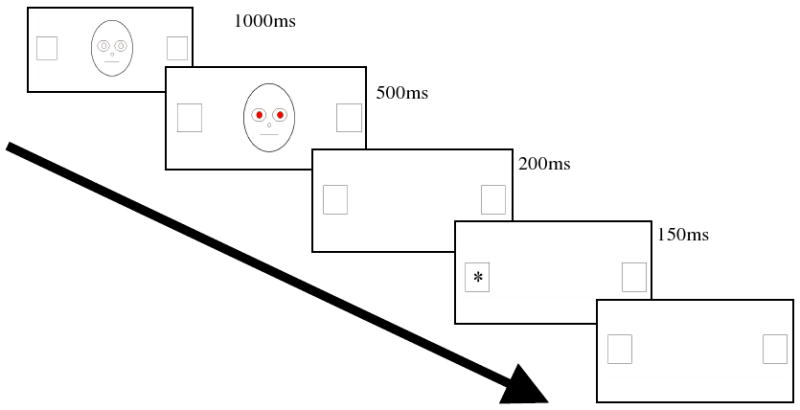
Design of the task in gaze straight and gaze shift conditions.
The colored eyes could be looking either straight ahead or towards one of the two boxes, creating straight eyes and gaze shift tasks. In the gaze shift task, trials were facilitating when the eyes looked towards the target response or interfering when they looked in the opposite direction. In addition, trials could be presented in single color blocks or red and green mixed blocks. There were 16 blocks of 24 trials each. In blocked conditions, all trials were either green or red and in mixed conditions there were equal numbers of green and red trials presented in a random order. There were two tasks, eyes straight and gaze shift, each consisting of 2 blocks of green straight, 2 blocks of red straight, and 4 blocks of mixed color. All conditions were presented in one of eight counterbalanced orders. Prior to each task (straight eyes and gaze shift), participants received practice blocks that consisted of 8 trials that were repeated if necessary.
Each manipulation addressed one of three executive control components: Response suppression was assessed by the difference between red and green eye trials; inhibitory control was assessed by the difference between gaze shift and straight eye trials; switching was assessed by the difference between mixed and single block presentations. The control condition to establish baseline rate for choice reaction time was straight green eyes presented in single block trials, involving no demands for executive control.
Results
Mean accuracy for all conditions in the faces task ranged from 97% to 98%, with no difference between language groups or gender, Fs < 1. An initial analysis of RT indicated no main effect or interactions for gender, so all the data are collapsed across gender.
The mean RTs for the straight eye task, presented in Figure 2, were analyzed by a 3-way ANOVA for eye color, presentation (blocked, mixed), and language group. There were main effects for all three factors: language group, F (2, 87) = 293.96, p < .0001, eye color, F (1, 87) = 721.15, p < .0001, and presentation condition, F (1, 87) = 43.82, p < .0001, and a three-way interaction with all the factors, F (2, 87) = 7.74, p <.001. There was no language group difference in the blocked presentations, but both bilingual groups were faster than the monolinguals on green, F (2, 87) = 332.77, p < .0001, and red eye trials, F (2, 87) = 547.78, p < .0001, in the mixed presentation. The two groups of bilinguals were equivalent to each other and faster than the monolinguals (Scheffé, p <.01).
Figure 2.
Mean RT and standard error for (a) blocked and (b) mixed presentation conditions in gaze straight task.
The mean RTs for the gaze shift task, shown in Figure 3, were analyzed by a 4-way ANOVA for eye color, direction of gaze shift, presentation type, and language group. There was a main effect of language group, F (2, 87) = 1104.40, p < .0001, in which the two bilingual groups obtained faster RTs than the monolingual group, with no difference between the bilingual groups (Scheffe, p <.01). There were no interactions between language group and any other factor. Blocked presentations were faster than mixed presentations, F (1, 87) = 433.51, p < .0001, and green eyes were faster than red eyes, F (1, 87) = 157.72, p < .0001, with an interaction between presentation and eye color, F (1, 87) = 25.55, p < .0001, because of larger eye color differences in the blocked presentation. Importantly, none of these effects interacted with language group. Finally, there was a main effect of gaze direction, F (1, 87) = 18.79, p < .0001, in which trials looking towards the target were faster than those in which the eyes looked away. This factor did not interact with any other variable in the design.
Figure 3.
Mean RT and standard error for (a) blocked and (b) mixed presentations in gaze shift task.
These results were used to calculate costs for response suppression, inhibitory control, and switching, presented in Figure 4. Response suppression was operationalized as the RT difference between red eye and green eye trials (combining Figures 2 and 3). A one-way ANOVA for language group showed that the difference between the three groups was not significant, F (2, 87) = 2.38, p = .10. Inhibitory control was calculated as the difference between mixed presentation trials that included gaze shift and mixed presentation trials with straight eyes1, the only difference being the need to ignore the direction of gaze (comparing Figures 2b and 3b). Monolinguals produced a larger cost than either of the two bilingual groups, F (2, 87) = 21.34, p < .0001, with the two bilingual groups not different from each other. Switching costs, calculated as the RT difference between blocked and mixed presentations (comparing Figures 2a and 3a with Figures 2b and 3b), led to a significant effect of language group, F (2, 87) = 102.55, p < .0001, again because of greater costs for the monolinguals than either of the bilingual groups who were not different from each other. In fact, the bilinguals showed no cost of switching, with RT in blocked and mixed trials not significantly different, Fs < 1. A similar result was found for young adults with this task (Bialystok et al., 2006).
Figure 4.
Mean RT costs in ms and standard error by group for suppression (RT difference for red eye trials and green eye trials), inhibitory control (RT difference for straight eyes and gaze shift in mixed presentations), and switching (difference between mixed and blocked presentations).
Discussion
The first purpose of the study was to identify the components of executive control that develop differently in bilingual children. In spite of comparable performance on background measures and on the control condition, the bilinguals were more skilled than the monolinguals in performing conditions that required inhibitory control and switching but not response suppression. Thus, contrary to earlier claims (e.g., Bialystok, 2001), bilinguals do not differ from monolinguals simply in inhibitory control but also demonstrate differences in the cognitive flexibility that underlies task switching. Equally important, the results support a distinction between two processes that are frequently conflated under the term ‘inhibition’ in both development (Zelazo, Muller, Frye, & Marcovitch, 2003) and adult performance (Miyake et al., 2000). The differential effect of bilingualism on response suppression and inhibitory control points to their distinctiveness.
The second purpose was to evaluate the generality of these patterns by comparing bilingual children in two cultures. The bilingual children in Canada and in India spoke different languages, represented different cultures, and had different social and immigration experiences. Yet, in all comparisons in which there were group differences, the bilinguals in Canada and India performed similarly to each other and differently from the monolinguals in Canada. The cultural differences between the two bilingual groups in the present study were far greater than the usual comparisons of socioeconomic groups within the same country or immigrants and native residents of a country. The bilingual children in both settings used both languages daily, and in both cases the language of schooling was different from the language of home. Moreover, the two bilingual groups were different in that the Canadian bilinguals spoke a variety of non-English languages but the Indian bilinguals were linguistically homogeneous. If the relevant factor in such studies were social class, then all children would have performed equivalently because this feature was constant. If the relevant factor were immigration histories, then the Canadian bilinguals would perform differently from the other two groups because they were the only immigrants. If the relevant factor were cultural experiences, then the two Canadian groups would have performed similarly because their lives are most similar and they attended the same schools. However, the results clearly showed the similarity in performance for the two groups who share the experience of bilingual language use. No study to date, using any age group, has been able to demonstrate this point.
In a previous study, the same task was administered to younger and older adults (Bialystok et al., 2006). Both younger and older bilinguals demonstrated advantages over monolinguals in inhibitory control but the older adults showed enhanced performance for all three components. With children, the advantages were found for inhibitory control and switching. Together, these results suggest that the modification of components of executive function by bilingualism is different at various stages of the lifespan, possibly because of differences in accumulated experience or the stability of executive functioning. It appears that bilingualism has no effect on accelerating the development of control over habitual motor responses, that is, response suppression, but lifelong bilingualism protects against its decline in older age.
The present study adds to previous research by isolating two components of executive control that are affected by childhood bilingualism and ruling out one that is not. These results, in conjunction with those of Bialystok et al. (2006) contribute to an understanding of lifespan changes in executive control by comparing the outcomes in different age groups. Such detail is essential for establishing the mechanism by which bilingualism and other experiences affect cognition and development. The results also confirm that these effects override cultural and linguistic differences. Finally, the study contributes to a clearer conception of the components of executive control by dissociating two types of inhibition in bilingual children.
Acknowledgments
We are grateful for the assistance of Dr. Krishna of Boston Matriculation Higher Secondary School and Mrs. Seethalakshmi Raghavan and Mrs. Shanthi Krishnamurthy of M.CT.M Chidambaram Chettyar Matriculation Higher Secondary School in recruiting children from their schools in Chennai, India to participate in this study. The research was partially supported by grant R01HD052523 from the US National Institutes of Health and by grant A2559 from the Natural Sciences and Engineering Research Council of Canada to the first author.
Footnotes
In the study by Bialystok, Craik, & Ryan (2006), inhibitory control was calculated as the difference in RT between trials in which the eyes looked towards the target and those in which the eyes looked away from the target in the gaze shift task. The calculation used in the present study indicates the ability to ignore the eye gaze relative to conditions that are identical except for the presence of eye gaze. This seems to be a clearer measure of inhibitory control. An analysis using the original formula on the present data showed the same effect in which monolinguals had greater cost for the misleading direction than either of the bilingual groups.
Publisher's Disclaimer: This is a PDF file of an unedited manuscript that has been accepted for publication. As a service to our customers we are providing this early version of the manuscript. The manuscript will undergo copyediting, typesetting, and review of the resulting proof before it is published in its final citable form. Please note that during the production process errors may be discovered which could affect the content, and all legal disclaimers that apply to the journal pertain.
References
- Bialystok E. Bilingualism in development: Language, literacy, and cognition. New York: Cambridge University Press; 2001. [Google Scholar]
- Bialystok E. Effect of bilingualism and computer video game experience on the Simon task. Canadian Journal of Experimental Psychology. 2006;60:68–79. doi: 10.1037/cjep2006008. [DOI] [PubMed] [Google Scholar]
- Bialystok E. Global-local and trail-making tasks by monolingual and bilingual children: Beyond inhibition. Developmental Psychology. doi: 10.1037/a0015466. in press. [DOI] [PMC free article] [PubMed] [Google Scholar]
- Bialystok E, Craik FIM, Klein R, Viswanathan M. Bilingualism, aging, and cognitive control: Evidence from the Simon task. Psychology and Aging. 2004;19:290–303. doi: 10.1037/0882-7974.19.2.290. [DOI] [PubMed] [Google Scholar]
- Bialystok E, Craik FIM, Luk G. Cognitive control and lexical access in younger and older bilinguals. Journal of Experimental Psychology: Learning, Memory, and Cognition. 2008;34:859–873. doi: 10.1037/0278-7393.34.4.859. [DOI] [PubMed] [Google Scholar]
- Bialystok E, Craik FIM, Ryan J. Executive control in a modified anti-saccade task: Effects of aging and bilingualism. Journal of Experimental Psychology: Learning, Memory, and Cognition. 2006;32:1341–1354. doi: 10.1037/0278-7393.32.6.1341. [DOI] [PubMed] [Google Scholar]
- Bialystok E, Feng X. Language proficiency and its implications for monolingual and bilingual children. In: Durgunoglu A, Goldenberg C, editors. Challenges for language learners in language and literacy development. Guilford Press; in press. [Google Scholar]
- Bialystok E, Senman L. Executive processes in appearance-reality tasks: The role of inhibition of attention and symbolic representation. Child Development. 2004;75:562–579. doi: 10.1111/j.1467-8624.2004.00693.x. [DOI] [PubMed] [Google Scholar]
- Bialystok E, Shapero D. Ambiguous benefits: The effect of bilingualism on reversing ambiguous figures. Developmental Science. 2005;8:595–604. doi: 10.1111/j.1467-7687.2005.00451.x. [DOI] [PubMed] [Google Scholar]
- Bunge SA, Dudukovic NM, Thomason ME, Vaidya CJ, Gabrieli JDE. Immature frontal lobe contributions to cognitive control in children: Evidence from fMRI. Neuron. 2002;33:301–311. doi: 10.1016/s0896-6273(01)00583-9. [DOI] [PMC free article] [PubMed] [Google Scholar]
- Carlson SM. Executive function in context: Development, measurement, theory, and experience. Monographs of the Society for Research in Child Development. 2003;68(3):138–151. Serial No. 274. [PubMed] [Google Scholar]
- Carlson SM, Meltzoff AN. Bilingual experience and executive functioning in young children. Developmental Science. 2008;11:282–298. doi: 10.1111/j.1467-7687.2008.00675.x. [DOI] [PMC free article] [PubMed] [Google Scholar]
- Colzato LS, Bajo MT, van den Wildenberg W, Paolieri D, Nieuwenhuis S, La Heij W, Hommel B. How does bilingualism improve executive control? A comparison of active and reactive inhibition mechanisms. Journal of Experimental Psychology: Learning, Memory and Cognition. 2008;34:302–312. doi: 10.1037/0278-7393.34.2.302. [DOI] [PubMed] [Google Scholar]
- Costa A, Hernández M, Sebastián-Gallés N. Bilingualism aids conflict resolution: Evidence from the ANT task. Cognition. 2008;106:59–86. doi: 10.1016/j.cognition.2006.12.013. [DOI] [PubMed] [Google Scholar]
- Diamond A. Normal development of prefrontal cortex from birth to young adulthood: Cognitive functions, anatomy, and biochemisty. In: Stuss DT, Knight RT, editors. Principals of frontal lobe function. London, UK: Oxford University Press; 2002. pp. 466–503. [Google Scholar]
- Dunn LM, Dunn LM. Peabody Picture Vocabulary Test- 3rd Edition. Circle Pines, MN: American Guidance Service; 1997. [Google Scholar]
- Green D. Mental control of the bilingual lexico-semantic system. Bilingualism: Language and Cognition. 1998;1:67–81. [Google Scholar]
- Kavé G, Eyal N, Shorek A, Cohen-Mansfield J. Multilingualism and cognitive state in the oldest old. Psychology and Aging. 2008;23:70–78. doi: 10.1037/0882-7974.23.1.70. [DOI] [PubMed] [Google Scholar]
- Kovacs AM. Early bilingualism enhances mechanisms of false-belief reasoning. Developmental Science. 2009;12:48–54. doi: 10.1111/j.1467-7687.2008.00742.x. [DOI] [PubMed] [Google Scholar]
- Martin-Rhee MM, Bialystok E. The development of two types of inhibitory control in monolingual and bilingual children. Bilingualism: Language and Cognition. 2008;11:81–93. [Google Scholar]
- Meuter RFI, Allport A. Bilingual language switching in naming: Asymmetrical costs of language selection. Journal of Memory and Language. 1999;40:25–40. [Google Scholar]
- Miyake A, Freidman NP, Emerson MJ, Witzki AH, Howerter A, Wager TD. The unity and diversity of executive functions and their contributions to complex “frontal lobe” tasks: A latent variable analysis. Cognitive Psychology. 2000;41:49–100. doi: 10.1006/cogp.1999.0734. [DOI] [PubMed] [Google Scholar]
- Oller DK, Eilers RE. Language and literacy in bilingual children. Clevedon, England: Multilingual Matters; 2002. [Google Scholar]
- Reitan RM, Wolfson D. The Halstead-Reitan Neuropsychological Test Battery: Theory and Clinical Interpretation. Tucson, AZ: Neuropsychology Press; 1993. [Google Scholar]
- Zelazo PD, Muller U, Frye D, Marcovitch S. The development of executive function in early childhood. Monographs of the Society for Research in Child Development. Vol. 68. Boston: Blackwell Publishing; 2003. Serial No. 274. [DOI] [PubMed] [Google Scholar]



